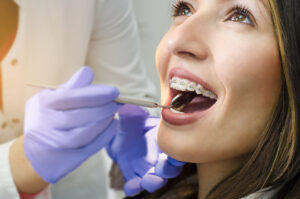There are a variety of types of braces to choose from for orthodontic treatment. However, it’s advisable to talk to an orthodontist to find out which braces would be best for your treatment and lifestyle.
Metal braces
Lingual braces
Ceramic braces
Self-ligating braces
The type you get depends on a number of things, ranging from cost to condition:
The condition and positioning of your teeth
Your orthodontist’s treatment plan
Your budget/willingness to pay beyond the basic necessity
Your personal preference
Keep reading to learn about the types of braces available today and how each provides unique possibilities.
Metal Braces
Metal braces are what most people initially think of when they think of braces. They are comprised of metal brackets cemented onto individual teeth, along with elastic ties, called ligatures, to hold the wire onto the brackets. These types of braces are very strong and can withstand most types of treatment. They also tend to be the most inexpensive and work in treating even the most severe cases. For many patients, the biggest draw to metal braces is that they tend to have the shortest treatment time when compared with other orthodontic solutions.
Metal braces aren’t without their downsides, though. They may irritate to the cheeks and gum, but patients often adjust to the feelings after a few weeks. Your orthodontist can provide you with wax to cover the most jagged edges while your mouth adjusts.
Lingual Braces
Lingual braces are most commonly made of metal, too, but the brackets are placed on the backs of the teeth, making them virtually invisible to others. This “invisibility” is the primary reason orthodontic patients choose lingual braces.
The downsides of lingual braces are the way they impact speaking and interfere with the tongue, due to placement on the back of the teeth. Some patients report irritation of their tongues. Additionally, the placement of the brackets makes it more difficult to clean the back of the teeth effectively simply because it’s harder to get to them. Lingual braces are more expensive and require a longer treatment period. Patients with severe overbites or other more severe conditions may not be good candidates for lingual braces. Talk to your orthodontist to know for sure.
Ceramic Braces
Ceramic braces are made of very strong materials that function similarly to metal braces. However, the brackets are tooth-colored, making them less noticeable than the shiny chrome-looking metal. The ligatures (tiny rubber bands) that hold the arch wire onto the ceramic brackets are often white or clear to keep the orthodontics discreet. They are a wonderful option for adults looking for orthodontic solutions that aren’t as evident as metal braces.
Ceramic braces can be used to treat nearly all of the same cases treatable by metal braces, and patients report less gum irritation compared to metal braces.
Downsides include the fact that the ligatures may stain after exposure to food and drink and become more noticeable over time, treatment is usually more expensive, and patients may have to wear the braces longer than those who opt for metal braces.
Self-Ligating Braces
Self-ligating braces are metal braces without the elastic ligature. Instead, the brackets themselves are designed with “trap door” technology that holds the wire in place and allows it to slide back and forth. This results in fewer adjustments, and fewer appointments. Otherwise, the treatment is very similar to metal braces.
What about Invisalign?
While Invisalign has proven to be effective as orthodontic treatment, it uses a different methodology to correct conditions.
To learn more about the types of orthodontic treatment that would best suit your unique needs, visit a local orthodontist.









